Just a witch doing my best. Dm me for tarot readings, spell work, or natal chart readings.
Don't wanna be here? Send us removal request.
Note
Hey Mate, got tips for Brigid Worship that doesn't involve American/English/Wiccan stuff? I'm an Irish ex-Catholic who's trying to worship the Tuatha Dé Danann (I'm mainly focusing on Brigid because I loved her Saint equivalent growing up), but a lot of my research keeps showing me English/American Neogpagan and Wiccan Shite. Any advice?
hey mate! i’ll link some resources for you to peruse, hopefully they help. mix up of gaelic-centric and celtic-centric pagan resources
Gaol Naofa (a website discussing Gaelic polytheism)
Tairis (another website discussing Gaelic polytheism)
An Introduction to the Tuatha Dé Danann (video)
Na hÉireanneach
A Smaller Social History of Ancient Ireland
Pagan Portals - Gods and Goddesses of Ireland: A Guide to Irish Deities
Gods and Fighting Men: The Story of the Tuatha De Danann and of the Fianna of Ireland (not sure where to link, this was lent to me! fer sure you can find it though)
The Cailleach in Irish Megalithic Traditions
Druids, Deer, and Words of Power: Coming to Terms with Evil in Medieval Ireland
The Book of Celtic Magic: Transformative Teachings from the Cauldron of Awen by Kristoffer Hughes
The Religion of Ancient Celts
Legendary Fictions of the Irish Celts
Brigid of the Celts
An Introduction to Celtic Reconstructionist Paganism
The Tain (amazon bleugh)
Irish Imbolc Customs
Scottish Deities: Brighde
Brighid, Goddess and Saint
Tending Brighid’s Flame (amazon bleugh)
How to Make a Brighid Cross from Rushes
to keep in mind while reading: Cailleach is not a member of the Tuatha Dé, and her lore supersedes theirs by a long shot. The Cailleach - Brighid dichotomy is specifically a Scottish folkloric tradition and does not appear in Irish folkloric tradition.
as far as personal experience, i don’t know much about brighid. never formed a bond with her, honestly, and she’s never shown interest in me in return. but i still celebrate her feast and do a lot of basic worship of her that day.
my main tip for you would be that, well... it’ll seem harsh, but coming from a fellow irish person, the tuatha de danann are nothing like the catholic god. they don’t love you unconditionally, and they aren’t omnipresent or all knowing. wise and powerful, fer sure, but your relationship with them will be completely different and unfamiliar at first.
the irish deities were originally venerated ancestors. they became divine as the legends of them spread. the tuatha de danann are more like if an EXTREMELY powerful and respected war general was your landlord. offerings are less about connection and more about payin’ your rent!
at the bare bones basics: there was an agreement between humans and them that they’d retreat from the war that was resulting in the near-extinction of both their peoples, IF the human invaders would leave part of their harvest goods for them on the mounds and edges of forests and windowsills on certain fests and holidays. with that deal struck, the tuatha de danann retreated underground beneath the faery mounds and very soil we stand on.
so keep in mind: the gods do not love you until you build that relationship. they’re not your parent, they’re not a friend. they are wiser, stronger, and more powerful than you in every way. holy fear should be part of it at first when it comes to irish deities. obviously you can still form a close bond, even worship them or become a close communicator! but you have to earn that first.
586 notes
·
View notes
Text
🌸🥚🫓 Arepa de Huevo (Arepa Stuffed with Egg) For Ostara🫓 🥚🌸
Im sharing another colombian recipe because this is my favorite food and I think more people should try it, also an egg based recipe is perfect for Ostara.
I swear not all colombian food is fried im just not the healthiest person around.
this recipie is from the caribean region of colombia and usualy eaten at breakfast or luch if you add ground meat.

As always magical correspondences under the cut
Keep reading
238 notes
·
View notes
Text
August 2022 Important Dates
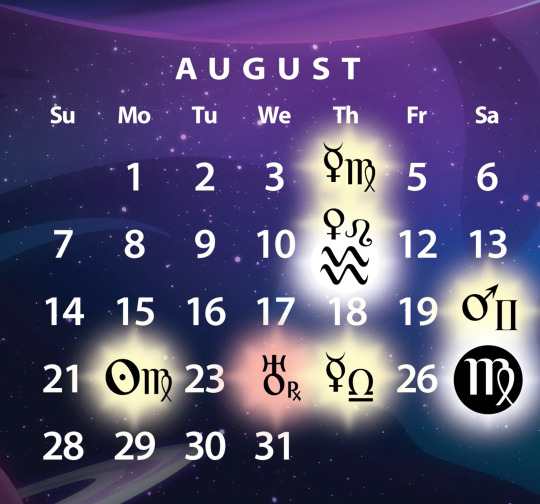
AKA my notes from the Astrology Podcast August forecast. To recap, Uranus in Taurus has indeed manifested in food & commodity shortages worldwide, for example the unrest in Sri Lanka. The Scorpio-Taurus eclipses have lined up with drastic market changes, and combined with the Saturn-Uranus square the next set of eclipses will likely indicated more crises of this sort.
Mars’s ingress into Taurus in July continues to overshadow much of August, which puts him in a T-square involving the Sun (♌), Uranus/Rahu (♉), and Saturn/full Moon (♒). In recent years fixed Mars-Saturn has coincided with spikes in different global health crises (ebola, covid, now monkeypox), and Chris points out that plagues were one of the Mars-Saturn significations in ancient texts that he was once quick to dismiss. Austin adds that as time goes on he finds that the oddly specific or seemingly quaint predictions of older texts seem to become more and more relevant if you pay attention.
August 1st - Mars, Uranus, and Rahu conjoin (18♉) (not pictured) Typical significations include accidents and injuries due to carelessness or recklessness. Guest host Nick Dagan Best says historically this masculine-seeming transit has actually lined up with the political/martial takedown of women in power: Marie Antoinette was beheaded close to a Uranus-Mars conjunction, as did the trials of Madame Mao in China in 1976 (and the Chariman’s death), the defeat of Mary, Queen of Scots, etc. On historic accidents, Austin points out that the explosion in Beirut last year occurred around a Mars-Uranus configuration: a volatile (Uranus) substance was being stored (Taurus) was ignited (Mars). In a natal chart, Frida Kahlo was born under a Mars-Uranus conjunction in the 6th house, opposite her ascendant ruler the Sun (in Cancer in the 12th house), and how a sudden bus accident (which occurred on a Mars-Uranus opposition) & subsequent injuries dramatically shaped the course of her life and work. Anyone with natal Mars-Uranus emphasis or who is accident-prone should especially avoid risk-taking in the beginning of August.
Overall, this configuration means that Saturn (♒), who was in the superior position over Uranus alone, won’t be able to win this 3-on-1 fight. On a more positive note, Robin Williams’ ascendant(♏) ruler Mars was conjunct Uranus (♋) in his natal chart, and he was well-known for his quirky, fast-paced humor. Nick points out he could take a boring talk show interview and make it into total anarchy, which made him such a popular and beloved comedian. In Taurus, we can also see rebels and radicals be the people involved in making food–protesting farmers in South Asia, the uprising of people against the existing social order for their basic needs. Another uprising involved in Mars-Uranus square Saturn is that, once Mars returned to Taurus about 18 months later, we have the congressional hearings about the January 6th events in the US. In broader history, Mars-Uranus square Saturn presided over the fall of Constantinople in the 1400s, considered the final end of Rome.
One thing to note is that Mars hits the exact conjunction to Uranus before squaring Saturn exactly, which may give Saturn a chance to reassert control. Mercury, the Sun, and the Moon will all square/oppose this configuration in a similar order: first Mars & Uranus, then Saturn. First a disruption, then attempts to reassert control. We’re also now on the upslope of a Saturn-Uranus conjunction that will peak in early November (obligatory Archetypal Explorer visualization below):
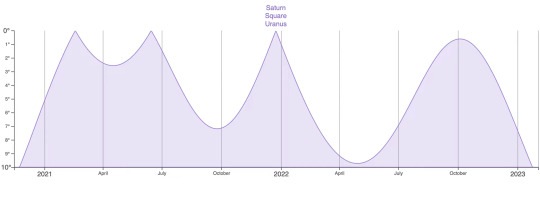
Overall we can see the disruption/destabilization of things we have taken for granted as basic foundations; perhaps that foundation was as strong as we thought it was. (For example, Roe v. Wade being overturned in the US). However, in individual nativities especially this can also have more positive outcomes. Having a Saturnian wall crumble can free you from a limitation you’ve always thought you had to live with. Whether you’re toppling structures that are no longer working for you or finding yourself newly freed by circumstance, there can also be many opportunities. We may realize that this crumbling has been going on for years–perhaps you first knew it needed to happen on the Taurus eclipse last November–but the final gust of wind knocking it over has given us clarity.
This is a kind of “season finale” for the Saturn-Uranus square that’s been plaguing us since the end of 2020–by March Saturn will be in Pisces, and it’ll be time for the Saturn-Neptune season. However, we do have an eclipse coming up (right on the day of midterm elections in the US!) that will accelerate some more disorder as we head into the end of this transit. Whatever troubles we encounter in the next few months will set the landscape for the next few years.
August 4th - Mercury enters Virgo Mercury both rules Virgo and exalts in this sign. It’s easily the most unhindered planet during the month of August, which Chris takes advantage of in the electional chart.
August 7th - Mars (22♉) squares Saturn (22♒) (not pictured) See last paragraph of August 1st.
August 11th - Venus enters Leo, Full Moon in Aquarius Here is the chart for the lunation, where the Sun is at 19 degrees of Leo and the Moon at 19 Aquarius (see alt text for interpretation of sign and planet symbols. Asc/Dsc = Ascendant/Descendant, and IC/MC = Imum Coeli/Midheaven):
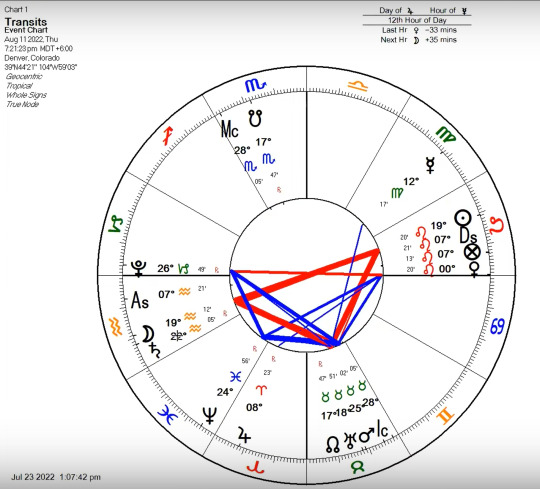
Soon afterwards the Moon will conjoin Saturn at 22 Aquarius, basically forming a “giant silver spotlight” (Austin’s words) on the Saturn-Uranus/Mars/Rahu tensions we’ve been discussing. This is quite similar to the summer of 1999, so look out for parallels in your life if you remember then.
Venus entering Leo puts her back into the danger zone, opposing Saturn and being squared by Uranus/Mars/Rahu (North Node). Venus in Leo normally gives us the vibes of classic summer fun, showing off and enjoying ourselves, and she’ll trine Jupiter around the 17th and 18th, emphasizing this before Uranus shakes up our supplies and Saturn chills us. We may be able to use this to our advantage by having “serious fun”–our hosts suggest going to the ISAR conference in Colorado, but generally think something more reserved yet enjoyable. Mercury in Virgo really is good for learning and speaking.
August 13th - Electional chart for the month
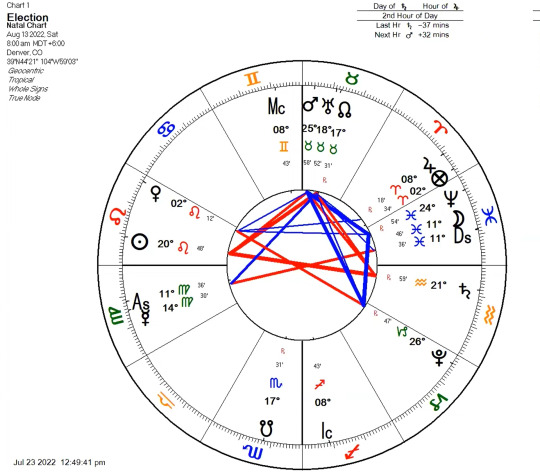
The Saturn-Uranus/Mars square casts a dark shadow over the month, but Mercury will be especially strong in Virgo, where it has both domicile and exaltation. The chart is for around 8:00AM local time, with mid-Virgo rising and a fast, not-afflicted Mercury on the Ascendant. With mutable signs on angular houses, the Taurus-Leo-Aquarius difficulties are pushed into the cadent houses and will be less prevalent. The Moon in Pisces in the 7th house is applying to an opposition with Mercury, and this is a good chart for all things Mercury: writing, communication, detail-oriented and practical tasks. Invention, innovation, and efficiently working through things. During times of unrest, we really need some mental clarity to asses our facts and gaps in knowledge. Additionally, Mercury rules the 10th house of Gemini as well as the 1st, making this chart potentially very powerful.
August 18th - Mars enters Gemini Due to the October retrograde, Mars will be in Gemini from now until March of next year. By the time Mars leaves Gemini, Saturn will have left Aquarius for several weeks. However, being somewhere other than a fixed sign will release a lot of that tension we feel when Mars and Saturn pull us in different directions. For individuals, pay special attention to the day of Mars’s ingress into Gemini, as the part of the chart activated by this transit can provide some clues as to what you’ll be revisiting during the retrograde.
Generally, Mars speeds things up for us a lot in this quick sign, especially areas of life that have been stagnating. Angular houses and Gemini placements can expect energy and capability to move. However, our attentions and energies can get frayed by trying to split our energy and attention between too many things–when you’re hitting the accelerator all the time, you run out of gas. Mars in Gemini can also indicate lawyers, fighting words, and cyber warfare and generally a competitive edge to Mercury’s games. Tactics and trickery can also come into play here–think trickster heroes or using your wits rather than brute strength to achieve victory. Don’t assume it’s gonna be a straight line; prepare for a lot of twists and turns.
Whatever house Gemini falls in for you is going to receive a lot of heat. How can we hydrate this area and keep it cool? How much competition do you need to be engaged, but not overwhelmed?
August 22nd - Sun enters Virgo The Sun leaves that fixed sign tensions.
August 24th - Uranus stations Retrograde The last station of Uranus coincided with, among other things, the US’s messy exit from Afghanistan. In general Chris advises us to pay attention to stations and I agree. I think stations and ingresses precipitate events most obviously (compared to, for example, aspects or lunations).
On the subject of Uranus, Austin wants to point out that Uranus isn’t always a revolutionary we want. The underdog isn’t necessarily the good guy, and the planet’s disruptive energy manifests in both desirable and undesirable shakeups. In the next few years we’ll see the buildup to Uranus in Gemini, which marks the US’s third Uranus return. Previous returns were the Civil War and entering World War II–strong economic positions being taken and unrest over commodity shortages abroad will likely set the stage for the next few years.
August 25th - Mercury enters Libra Mercury will station retrograde in this sign early in September.
August 27th - New Moon in Virgo Here is the chart for it:
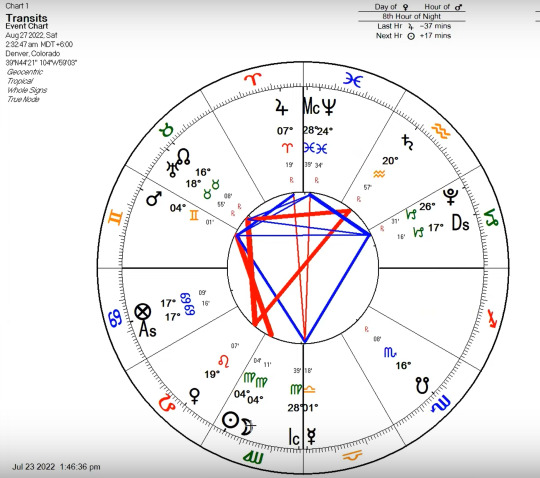
At 4 degrees of Virgo, this lunation early morning in Denver, or late at night further West. The lights perfectly square Mars in Gemini, and Venus is between exact hard aspects to Uranus and Saturn. Mercury (♎) opposing Jupiter (♈) will gives us some diplomacy in other areas of life. These two planets can show you how to play the devil’s advocate in a charming or well-placed way.
12 notes
·
View notes
Text
Our dear sweet nephew Stephen Michael Matthew Gray was lost tragically on Sunday. This sweet child is beloved by his family and will be missed tremendously. Please consider helping out with Stephen’s final expenses
https://gofund.me/f72a3392

13 notes
·
View notes
Text
Deity Work Guides: Brigid, Thor and Cernunnos

Brigid
Culture: Celtic
Goddess of: Spring, Fertility, Family, The Hearth, Childbirth, Fire, Blacksmiths, Scholars, Physicians, Prophets, Healing, Poetry, Occult knowledge, and Justice
Symbols: Brigid’s Cross, Candles, Triquetra, Faeries, Four leaf clovers, Cauldron, Chalice, Corn Dolly, Anvil, Hammer, Poetry, Forges, Hearths, Wells and Rock Formations
Colours: Green, Red, White, Gold and Blue
Animals: Snakes, Ewes, Sheep, Cows, Bees, Oxen, Owls and Hibernating animals
Plants: Cinnamon, Chamomile, Blackberry, Hawthorn, Basil, Mugwort, Apple, Heather, Dandelion, Snowdrop, Willow, Oak, Shamrock, Crocus, Trillium, Corn, Lavender and Sage
Incense: Myrrh, Wisteria, Frankincense, Cinnamon
Other Associations: Water and Fire,
Offerings: Blackberries, Milk, Bread, Herbal Teas, Heather, Brigid’s Cross, Beer
Devotional Acts:
Dedicate some Art to her
Meditate with fire
Learn blacksmithing
Watch the sunrise
Say hello to Cows and Sheep
Hang a Brigid’s Cross above your doorway for blessings and protection
Study healing magic
Plant a bee garden

Thor
Culture: Norse
God of: Thunder, Lightning, Strength, Protection, Fertility, Masculinity, Protector of Humanity
Symbols: Mjolnir, Thurisaz Rune
Colours: Red, Gold, Blue and White
Animals: Goats, Bulls
Plants: Oak, Garlic, Onion, Gorse, Thistle, Hawthorn, Leeks, Houseleek, Mountain Ash, Hazel, Pine, Acorns, Oak Moss
Incense: Oak, Dragon’s Blood, Juniper, Pine, Rain and Amber
Other Associations: Strength, The Chariot, Thursday, Jupiter
Offerings: Hearty Foods with lots of meat or onions, Mead, Beer, Flattery, Oak, Whiskey, Coffee, Honey
Devotional Acts:
Be gentle and compliment others
Work out and be strong
Protect the vulnerable
Talk to him a lot. He flirts a lot too
Be out in the rain and safely admire a thunderstorm
Learn to craft with wood, especially oak
Watch Action Movies with him, like Lord of the Rings
Wear a Mjolnir necklace
Practice using weapons safely

Cernunnos
Culture: Celtic
God of: Forests, Wild Animals, Finances, The Underworld, Death, Hunting, Balance, Grounding and Healing, Transitioning into the Afterlife and Fertility
Symbols: Horns, The Torc, Gold Coins, Serpents
Colours: Yellow, Gold, Forest Greens, Silver, Black
Animals: Stags, Elk, Goats, Deer, Bulls, Horses, Ram Horned Snakes, Snakes, Boars, Owls, Hawks, Ravens
Plants: Ash, Bayberry, Chamomile, Cedar, Cinnamon, Heliotrope, Holly, Ivy, Lavender, Juniper, Myrrh, Nettle, Oak, Patchouli, Pine, Sandalwood, Sunflower, Vine, Yarrow
Incense: Musk, Benzoin, Frankincense, Patchouli, Pine
Other Associations: Earth and Air, Sunday,
Offerings: Venison, Cooked Meats (ethically sourced), Roses, Sunflowers, Lavender, Wildflowers, Juniper Bark and Berries, Oak wood carvings, Green or Gold Candles, Cinnamon, Cloves, Pine scents, Pelts (ethically sourced), Feathers, Bones, Forest Moss, Antlers, Horns, Pine Cones, Gold Coins, Daggers, Poetry art, Celtic Music
Devotional Acts:
Hiking and Hunting
Connecting with nature
Meditation and Grounding, especially Outside
Dancing
Listening to Irish/Celtic Music
Cooking with his favorite foods
Talking with him
Singing in Irish
Wearing a pendant for him
Taking care of your body, especially if you're chronically ill
504 notes
·
View notes
Text
Building a Magical Home
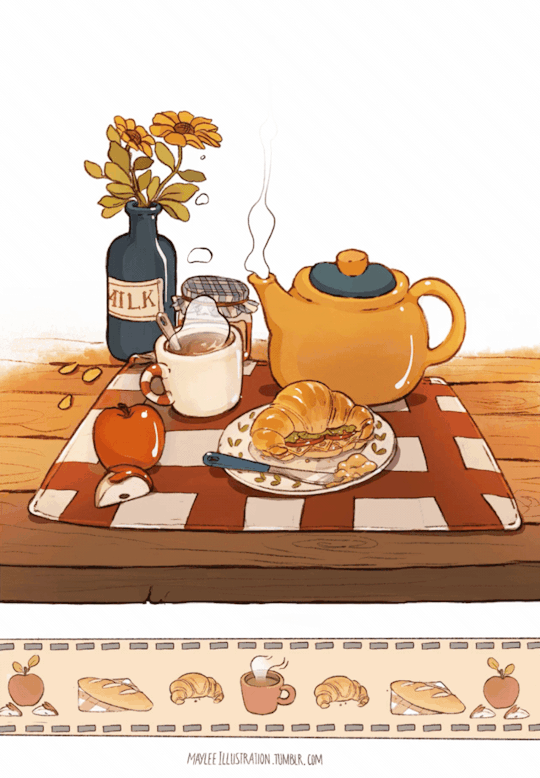
One of my favorite quotes about the magic of homemaking comes from Cory Hutcheson, host of the New World Witchery podcast. He says, “Home is a transformational act. It is the thing you do to turn a space into a space… that is full of ritual and significance and meaning. So there is sort of this ongoing relationship you have with the space that makes it a home.”
The act of creating a home, of making a space your own, is inherently magical. But if you want to make your space feel a little more witchy, here are some ideas to get you started.
Charms and Talismans
Making your own magical objects can be a powerful way to bring magic into your space. The best thing about making your own charms is that you can make them look however you want, so it’s easy to disguise them as ordinary household objects. You can make a charm for any intention by combining objects based on their magical correspondences.
I’ve talked about protective charms in previous posts, so I’m not gonna spend a lot of time on it here. The simplest protective charm is keeping a large piece of iron under your bed to keep away nightmares, evil spirits, and negative energy. You could also make your own protection charm, like a witch bottle.
You can create a “happy home” charm to bring peace, harmony, and happiness into your home. This charm could include herbs like basil, rosemary, lavender, peppermint, and/or bay leaves, as well as other items that you associate with peace and good fortune, like lucky coins, crystals, or black cat fur. Write your desires for a harmonious and happy home on a piece of paper, fold it up, and add it to the charm. You could store these items in a green bag, bury them in your backyard (in this case, make sure you’re only using biodegradable plant matter — leave out the coins and crystals), or place it inside a household object like a lamp or an end table.
If you suffer from insomnia or other sleep issues, try making a dream charm to help you sleep well and have sweet dreams. To make a simple dream charm, fill a blue or purple bag with lavender, chamomile, peppermint, and any other objects that you associate with peace, restfulness, and sleep. If you want to have lucid dreams or receive psychic messages in your dreams, include a bit of mugwort. Place the charm in your pillow or under your mattress. (I personally swear by this one, as it’s helped a lot with my insomnia.)
Charms are great for homemaking magic because you’re actually creating a magical object, which can then become a permanent fixture of the space.
Magical Decor
You can use magical items to decorate your home to bring certain qualities into that space.
Hanging or displaying a broom is said to bring good fortune, protection from evil, and good hospitality. Cauldrons are used to represent the Goddess, rebirth, and raw potential. Horseshoes hung above door frames bring safety and luck to all who cross under them, and keep unwanted guests away. If you can get them legally and ethically, animal bones, teeth, claws, and feathers can represent the spirit and energy of that animal. You can also put up images of spiritual and occult symbols — I have an image of the Sun tarot card hanging in my bedroom to promote positivity and growth.
If you need to be a little more subtle with your witchy decorations, working with the magic of color is a great way to do that. Gathering a lot of items of a single color in one room changes the energy of that room. Here’s a quick guide to give you some ideas:
Yellow is associated with divination, mental clarity, the element of air, success, communication, and inspiration.
Purple is associated with divine power, spiritual awareness, mystery, astral travel, magic, and authority.
Blue is associated with healing, psychic abilities, the element of water, peace, truth, and patience.
Red is associated with protection, the fire element, sex, power, vitality, and love.
Orange is associated with ambition, creativity, breaking through blockages, and career success.
Pink is associated with romantic love, friendship, self love, compassion, and emotional well-being.
Green is associated with nature, herbalism, the earth element, money, wealth, prosperity, and luck.
Brown is associated with grounding, animal magic, stability, and balance.
White is associated with purification, cleansing, the full moon, new beginnings, healing, and spiritual growth.
Black is associated with protection, truth, outer space, banishing, and transition.
Decorating your home with colors that are meaningful to you can create a powerful magical space. You may also have your own color associations (for example, yellow is a very “happy” color for me), so feel free to incorporate those into your decor as well!
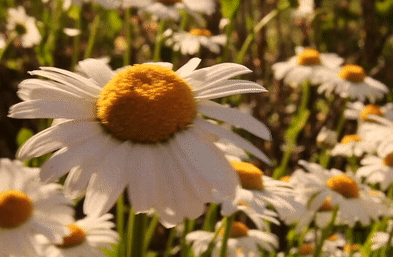
Growing Magical Houseplants
Most witches feel a very deep connection to nature and draw power from the natural world, but we can’t all live in a cottage in the heart of the forest. Even if you live in a tiny apartment in the city, you can still bring nature into your space by keeping houseplants. Many popular houseplants have magical uses, and many popular magic herbs can be grown inside. Here are a few to get you started.
Aloe. This is one of my favorite plants. Aloe brings luck and protection, especially protection on an energetic/spiritual level. I like to keep aloe in my bedroom to protect me while I sleep, as well as to bring luck and inspiration while I’m working at my desk.
Basil. Basil is very popular in money spells, and will attract prosperity and luck to your home. However, it also has protective properties — both spiritual protection and protection from bugs, since basil is a natural insect repellent! Basil can also be used in love spells, and is just generally a good plant to have around for good vibes.
African Violet. This flowering plant attracts positive spiritual energy into your space. It has associations with the moon and the water element, and is very good for promoting spirituality and psychic power.
Rosemary. Rosemary is one of those herbs that every witch should have on hand. It’s so darn versatile, it can be used as a substitute for virtually any other herb, and can be used for almost any intention. Some of the most common magical associations for rosemary include: cleansing, purification, protection, healing, mental activity, and enhancing memory. According to author Deborah J. Martin, there’s an old English saying that, “Where rosemary grows, the woman rules the house.” Like basil, rosemary is a natural insect repellent.
Lavender. Lavender brings peace, love, and gentleness, which makes it a perfect addition to any home. It can be used in spells for cleansing and purification, enhancing psychic abilities, and stress relief. Lavender is also a powerful addition to love spells. Keeping lavender in the bedroom can aid in restful sleep, while lavender in the kitchen will bring harmony to the home.
Sage. Sage is the most talked about cleansing herb, and with good reason. Unfortunately, a lot of the sage bundles you can buy at metaphysical stores are made with white sage (Salvia apiana), which is sacred to Native American peoples and is endangered due to overharvesting. Instead of buying those, why not grow your own garden sage (Salvia officinalis), which has a lot of the same magical properties? Growing sage in your home will purify the space and protect those who live there. Sage also has an association with wisdom and mental prowess.
Hoya. Hoya is a common houseplant that you’ve probably seen even if you don’t know it by name. It has a distinctive appearance with waxy, dark green leaves and clusters of white, star-shaped flowers. Hoya aligns and balances the energy centers within your body, as well as in the surrounding space. It’s associated both with grounding and with spiritual openness, so it can be great for balancing the two.
Peppermint. Peppermint has a variety of magical uses, but my favorite way to use it is for gently opening up blockages and getting things moving. It’s great for cleansing, but is more gentle than rosemary or sage. Place it in any room where you tend to do a lot of healing work, or where you could use some peace and love. Peppermint is also used in dream magic, so growing it in the bedroom may bring on vivid or lucid dreams.
Orchid. Orchids are used in magic for love and lust. Historically, orchid has been used in folk medicine to promote male virility and “Jezebel root,” used in American folk magic to attract wealthy male lovers, is a type of orchid root. If you live with a significant other, try growing an orchid in the bedroom to promote passion in your sex life. Otherwise, grow orchids in your home to promote love or to attract romance.
Catnip. If you have cats, they’ll love this one. Catnip is actually a type of mint, and has strong lunar associations. It’s said to make one more charming and attractive, and is especially useful for attracting women. At the same time, catnip promotes courage and fierceness. It is also, of course, associated with cats and feline deities, so this is definitely a plant you’ll want to keep around if the cat is one of your animal guides.
If you have a yard space that you can turn into an outdoor garden, your magical plant options are limited only by your local ecosystem. Some outdoor plants that have magical uses include roses, sunflowers, rue, lemon balm, and strawberries.
Creating an Altar
Altars are focal points of magical and spiritual energy. Many people, both witches and non-witches, find that having a designated space for their spiritual practice creates a deeper sense of sacredness and purpose.
An altar can serve lots of different purposes. Many witches use their altar as a magical work space to prepare spells, meditate, and do divination. You may choose to dedicate your altar to a deity, your ancestors, or some other spirit(s) you work with. You can also build altars for specific intentions, such as a money altar or a love altar — performing rituals at this altar everyday is a powerful method for manifestation. You altar may be some or all of these things, or it may just be a place to sit and connect with the spiritual.
You can set up an altar on any flat surface, like a shelf or table, or inside a container like a jewelry box. Your setup can be as simple or as elaborate as you like. An altar can be huge and complex, with statues and candles and flowers, or it can be as simple as a tealight and an incense burner. It’s all about what appeals to you.
Resources:
New World Witchery pocast, “Episode 143 — The Magical Home”
Southern Cunning: Folkloric Witchcraft in the American South by Aaron Oberon
Wicca: A Guide for the Solitary Practitioner by Scott Cunningham
“Candle colors and their meanings” by Michelle Gruben on the Grove and Grotto blog
Green Witchcraft by Paige Vanderbeck
A Green Witch’s Cupboard by Deborah J. Martin
“The Magic of Orchids in Wiccan Love Spells & Rituals” on the Art of the Root blog
22K notes
·
View notes
Photo

A sigil I made for strong, healthy, and protected plants! Feel free to use it :)
43 notes
·
View notes
Text
Beltane
may 1st
(bealtaine, cétamain, boaldyn, beltany, calan mai, may day, walpurgis nacht, floralia)
from gaelic “bael” (bright fire)
festival of sunlight, fertility, fire
honors Irish god of fire, Bel
the first day of summer in celtic tradition
the day cows are put out into the pastures
in norse myth, this is the time Othan hung himself from Yggdrasil and learned the runes
foods
sweets/honey
leafy greens
shellfish (aphrodisiac)
oats
strawberries
honey mead, ale, herbal wines
ice tea, lemonade
activities
dancing around the maypole
morris dancing
balefires (use oak, apple, hawthorn, birch, elder, ash, blackthorn, grape vine, mountain ash (rowan), holly, willow, cedar, yew, and hemlock)
decorating with hawthorn branches
divination
fertility rituals
visit a well
make and wear leaf masks
wash your face with dew for beauty
purify with ashes
corrospondences
herbs: all-heal, blessed thistle, broom, curry, daffodil, dogwood, coriander, dragon's blood reed, fern, fireweed, nettle, flaxseed, hawthorn, marjoram, paprika, radish, rue, snapdragon, mushroom, almond, meadowsweet, rose, woodruff, tansy, elder leaves
incence: jasmine, musk, ylang ylang, rose, vanilla
colors: pink, crimson, violet, yellow, rainbow
stones: carnelian, emerald, rose quartz, bloodstone, citrine
animals: rabbit, goat, bee, cat, satyr
Calan Mai (Wales)
known as an ysbrydnos (spirit night)
starts on may eve
singing may carols
couples go into the woods to spend time alone and picnic
Walpurgis Nacht (Germans)
days to celebrate St. Walpurga
begins april 30 and ends on may day
St. Walpurga healed, and protected
they say her tomb produces healing oil
bonfires were lit to drive off spirits
Floralia (Italy)
roman holiday of flowers
honors goddess Flora
april 28 to may 3
included nude dances, gladiator shows, release of hares and goats, scattering seeds

#beltane#may day#beltaine#bealtaine#calan mai#balefire#maypole#morris dancing#walpurga#walpurgis night#walpurgisnacht#grimoire
26 notes
·
View notes
Text

BEALTAINE
Also called Cétsamhain, the festival of Bealtaine marked the beginning of the summer season in Ireland when the cattle were driven to greener pastures. Typically observed on May 1st (though the day's festivities would normally begin on the previous evening), Bealtaine is one of four major festivals that shaped the old Irish year. According to Sanas Cormaic, an early Irish glossary, the festival of Bealtaine was marked by the driving of cattle between two bonfires to safeguard them against disease in the coming year. Indeed, all the way up to modern times, the lighting of bonfires has been a centerpiece of Bealtaine traditions, as has the association with protection; many supernatural beings were said to be afoot at this time, and giving away one's goods, such as fire or butter, could spell bad luck and scarcity for the months ahead. This design features rowan branches, marsh marigold, Irish primrose, and a rowan cross tied with red thread, all of which, according to folkore, would be common sights on Bealtaine, and were said to protect against witches and fairies. Cattle and fire, of course, represent the most enduring element of the tradition, from Cormac to the 19th century, and all the way into modern revivals.
#celtic#celtic art#mythology#irish mythology#celtic mythology#folklore#ireland#bealtaine#beltane#cetsamhain#wheel of the year#ogham#pagan#pagan art#gaelpol#artists on tumblr#forfedaproject#grimoire
153 notes
·
View notes
Note
Hey Mate, got tips for Brigid Worship that doesn't involve American/English/Wiccan stuff? I'm an Irish ex-Catholic who's trying to worship the Tuatha Dé Danann (I'm mainly focusing on Brigid because I loved her Saint equivalent growing up), but a lot of my research keeps showing me English/American Neogpagan and Wiccan Shite. Any advice?
hey mate! i’ll link some resources for you to peruse, hopefully they help. mix up of gaelic-centric and celtic-centric pagan resources
Gaol Naofa (a website discussing Gaelic polytheism)
Tairis (another website discussing Gaelic polytheism)
An Introduction to the Tuatha Dé Danann (video)
Na hÉireanneach
A Smaller Social History of Ancient Ireland
Pagan Portals - Gods and Goddesses of Ireland: A Guide to Irish Deities
Gods and Fighting Men: The Story of the Tuatha De Danann and of the Fianna of Ireland (not sure where to link, this was lent to me! fer sure you can find it though)
The Cailleach in Irish Megalithic Traditions
Druids, Deer, and Words of Power: Coming to Terms with Evil in Medieval Ireland
The Book of Celtic Magic: Transformative Teachings from the Cauldron of Awen by Kristoffer Hughes
The Religion of Ancient Celts
Legendary Fictions of the Irish Celts
Brigid of the Celts
An Introduction to Celtic Reconstructionist Paganism
The Tain (amazon bleugh)
Irish Imbolc Customs
Scottish Deities: Brighde
Brighid, Goddess and Saint
Tending Brighid’s Flame (amazon bleugh)
How to Make a Brighid Cross from Rushes
to keep in mind while reading: Cailleach is not a member of the Tuatha Dé, and her lore supersedes theirs by a long shot. The Cailleach - Brighid dichotomy is specifically a Scottish folkloric tradition and does not appear in Irish folkloric tradition.
as far as personal experience, i don’t know much about brighid. never formed a bond with her, honestly, and she’s never shown interest in me in return. but i still celebrate her feast and do a lot of basic worship of her that day.
my main tip for you would be that, well... it’ll seem harsh, but coming from a fellow irish person, the tuatha de danann are nothing like the catholic god. they don’t love you unconditionally, and they aren’t omnipresent or all knowing. wise and powerful, fer sure, but your relationship with them will be completely different and unfamiliar at first.
the irish deities were originally venerated ancestors. they became divine as the legends of them spread. the tuatha de danann are more like if an EXTREMELY powerful and respected war general was your landlord. offerings are less about connection and more about payin’ your rent!
at the bare bones basics: there was an agreement between humans and them that they’d retreat from the war that was resulting in the near-extinction of both their peoples, IF the human invaders would leave part of their harvest goods for them on the mounds and edges of forests and windowsills on certain fests and holidays. with that deal struck, the tuatha de danann retreated underground beneath the faery mounds and very soil we stand on.
so keep in mind: the gods do not love you until you build that relationship. they’re not your parent, they’re not a friend. they are wiser, stronger, and more powerful than you in every way. holy fear should be part of it at first when it comes to irish deities. obviously you can still form a close bond, even worship them or become a close communicator! but you have to earn that first.
#wiccans dni please#resources#irish mythology#irish pagan#brighid#brigid#saint bride#an cailleach#gaelpol#ireland#polytheism#paganism#gaelic paganism#celtic paganism#celtic polytheism#Irish polytheism#scottish pagan#scotland#scottish polytheism#books#reading#reading recommendations#scottish mythology#gaelic mythology#gaelic polytheism#celtpol#neodruid#druid#grimoire
586 notes
·
View notes
Text
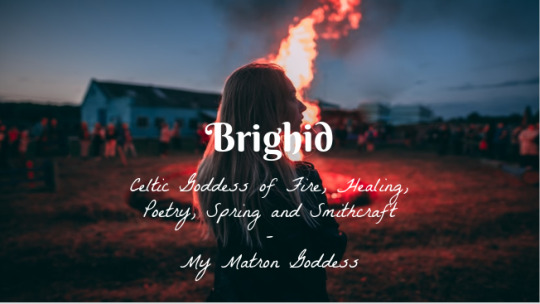
In Irish mythology, Brigid is the daughter of the Dagda and had two sisters also named Brigid and is part of the Tuatha de Danann, the supernatural Irish race. The three sisters made up the triple aspect of the one goddess: Brigid of the hearth, Brigid of the forge and Brigid of Inspiration. She is a goddess of spring, fertility, family, the hearth, childbirth, fire, blacksmiths, scholars, physicians, prophets, healing, poetry, occult knowledge, and justice. She was said to be born at sunrise and is often depicted with solar rays coming out of her head, making her one of the Irish solar deities alongside Lugh. It is said that wherever she walks four leaf clovers and flowers will grow. She also created the tradition of “keening” when her son Ruadan died in battle, a song-like wail used by women at funerals. In some cases she is also the goddess of sacred wells, springs and healing waters.
History
Her name comes in different spellings like Brig, Brighid, Brigit, or Brigid but it means “Exalted one” or “Fiery arrows”. She is a goddess of Pre-christian Ireland but versions of her are found all over Europe; she has ties to Brigantia, a warrior goddess of the Brigantes tribe of Britain. She was a beloved goddess of the Celts and has survived through centuries including the Christianization of Ireland and the rest of Europe where most traces of Druidism and Paganism were forgotten. The people of Ireland loved her so much and refused to let her be demonized by the church -like the rest of the gods- that they converted her into a saint known as St. Brigid of Kildare. There are also three rivers named after her one in Ireland, Wales and England: Brigit, Braint and Brent.The river that runs through Wales is known to have healing properties.
Imbolc
Also known as Brigid’s day, Candlemas or St. Brigid’s feast, Imbolc is one of the four fire festivals in Celtic paganism and celebrates the return of spring. Since Brigid is the goddess of spring and was said to go away during the winter, people would light a candle in honor of her return. Offerings of milk, bread, and corn cakes were set out and a seat at the dinner table was left open for her presence. Cows and sheep were seen as sacred to the goddess because they would provide milk for the town during the cold months and they would give birth around Imbolc. This festival celebrated the Maiden aspect of Brigid and young women would carry corn dollies dressed in white which represented the goddess. The women would also dress in white and attend a special feast for Imbolc where young suitors could mingle with the ladies. Imbolc is a time of fertility, cleansing and the light returning after a long winter.
Correspondences
Elements- Water & Fire
Animals- snakes, ewes, cows, bees, oxen, owls and hibernating animals. Vultures
Plants- blackberry, hawthorn, basil, mugwort, apple, heather, dandelion, snowdrop, willow, oak, shamrock, crocus, trillium, corn, lavender and sage. Personal one is cinnamon and chamomile.
Crystals- amethyst, bloodstone, carnelian, garnet, moonstone, clear quartz, and peridot.
Symbols- Brigid’s cross, candles, triquetra, faeries, four leaf clover, cauldron, chalice, corn dolly, anvil or hammer, poetry, forges, hearths, wells, rock formations.
Colours- green, red, white, gold and blue
Devotional Acts
offer her blackberries, baked goods, milk and honey or beer
dedicate a piece of your art to her like painting, knitting, singing, etc.
meditate with fire
savour the warmth of the sun or fire
incorporate the elements of water and fire into your craft
write her a poem
watch the sun rise
say hi to cows and sheep :)
hang a Brigid’s cross above your doorway for protection and blessings
study healing magick, reiki, herbalism and faeries
wear the colours of fire or white
plant a bee garden

#brigid#celtic#deities#goddess#brighid#fire goddess#healing witchcraft#irish#celtic witch#druidism#grimore
4K notes
·
View notes
Note
Hey Mate, got tips for Brigid Worship that doesn't involve American/English/Wiccan stuff? I'm an Irish ex-Catholic who's trying to worship the Tuatha Dé Danann (I'm mainly focusing on Brigid because I loved her Saint equivalent growing up), but a lot of my research keeps showing me English/American Neogpagan and Wiccan Shite. Any advice?
hey mate! i’ll link some resources for you to peruse, hopefully they help. mix up of gaelic-centric and celtic-centric pagan resources
Gaol Naofa (a website discussing Gaelic polytheism)
Tairis (another website discussing Gaelic polytheism)
An Introduction to the Tuatha Dé Danann (video)
Na hÉireanneach
A Smaller Social History of Ancient Ireland
Pagan Portals - Gods and Goddesses of Ireland: A Guide to Irish Deities
Gods and Fighting Men: The Story of the Tuatha De Danann and of the Fianna of Ireland (not sure where to link, this was lent to me! fer sure you can find it though)
The Cailleach in Irish Megalithic Traditions
Druids, Deer, and Words of Power: Coming to Terms with Evil in Medieval Ireland
The Book of Celtic Magic: Transformative Teachings from the Cauldron of Awen by Kristoffer Hughes
The Religion of Ancient Celts
Legendary Fictions of the Irish Celts
Brigid of the Celts
An Introduction to Celtic Reconstructionist Paganism
The Tain (amazon bleugh)
Irish Imbolc Customs
Scottish Deities: Brighde
Brighid, Goddess and Saint
Tending Brighid’s Flame (amazon bleugh)
How to Make a Brighid Cross from Rushes
to keep in mind while reading: Cailleach is not a member of the Tuatha Dé, and her lore supersedes theirs by a long shot. The Cailleach - Brighid dichotomy is specifically a Scottish folkloric tradition and does not appear in Irish folkloric tradition.
as far as personal experience, i don’t know much about brighid. never formed a bond with her, honestly, and she’s never shown interest in me in return. but i still celebrate her feast and do a lot of basic worship of her that day.
my main tip for you would be that, well... it’ll seem harsh, but coming from a fellow irish person, the tuatha de danann are nothing like the catholic god. they don’t love you unconditionally, and they aren’t omnipresent or all knowing. wise and powerful, fer sure, but your relationship with them will be completely different and unfamiliar at first.
the irish deities were originally venerated ancestors. they became divine as the legends of them spread. the tuatha de danann are more like if an EXTREMELY powerful and respected war general was your landlord. offerings are less about connection and more about payin’ your rent!
at the bare bones basics: there was an agreement between humans and them that they’d retreat from the war that was resulting in the near-extinction of both their peoples, IF the human invaders would leave part of their harvest goods for them on the mounds and edges of forests and windowsills on certain fests and holidays. with that deal struck, the tuatha de danann retreated underground beneath the faery mounds and very soil we stand on.
so keep in mind: the gods do not love you until you build that relationship. they’re not your parent, they’re not a friend. they are wiser, stronger, and more powerful than you in every way. holy fear should be part of it at first when it comes to irish deities. obviously you can still form a close bond, even worship them or become a close communicator! but you have to earn that first.
#resources#irish mythology#irish pagan#brighid#brigid#saint bride#an cailleach#gaelpol#ireland#grimoire prompts
586 notes
·
View notes
Text
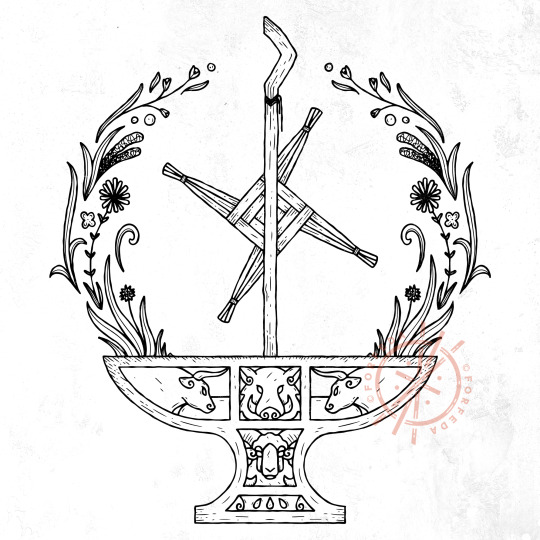
BRIGID
One of the most famous figures in all of Gaelic mythology is the goddess Brigid, said to be a wise woman and a daugher of the Dagda. In the Book of the Takings of Ireland, Brigid is said to possess two oxen, Fea and Femen; the King of Boars, the Torc Triath; and Cirb, the King of Sheep; each of which have plains in Ireland that bear their name. In the Second Battle of Moytura, Brigid is the wife of Bres and the mother of Ruadán, and when Ruadán is killed by Goibniu the smith, Brigid, in her grief, establishes the first practice of keening in Ireland. The Old Irish glossary Sanais Cormaic suggests that "Brigid" was a name for all the goddesses of Ireland, but that it referred specifically to three sisters: Brigid the Smith, Brigid the Poet, and Brigid the Healer, all daughters of the Dagda. The goddess Brigid has also long been syncretized with an Irish saint of the same name, who had an abbey in Kildare, and is depicted in Gaelic folklore as the nursemaid of Jesus. Saint Brigid's origins are ultimately a mystery, but her enduring and ever-present influence have lead many to theorize that she may be a euhemerized version of the goddess. This piece features an anvil, an ollamh's staff, and healing herbs to represent the domains of Cormac's Three Brigids, as well as a Cros Bríd to represent syncretism with the Irish saint. Engraved on the anvil are Brigid's boar, sheep, and two oxen, along with tears shed for Ruadán.
#celtic#celtic art#mythology#irish mythology#celtic mythology#folklore#ireland#pagan#pagan art#brigid#grimore#grimoire pages
612 notes
·
View notes
Text
Brigid of Kildare

Brigid (or Bríd in modern Gaelic) was a 5th century Irish woman who founded a religious community in Kildare, meaning “Chapel of the Oak Groves,” hinting at a pre-Christian, druidic significance to the location. Many scholars posit that Bríd was—before becoming a Christian when she was baptized by St. Patrick—seen as an extension of the Pagan goddess by the same name.
In Pagan Celtic communities, Bríd was associated with the welfare of the tribe in three ways:
She is a banfhile (a female poet) and inspires bards, artists, and communication of all kinds, including that with the Otherworld.
She is a patroness of domestic life, the hearth, and the forge. She’s a consort of smiths, presiding over the making of the weapons that warriors bear and the tools farmers use to work the land.
She is a healer, an herbalist, a purifier of the domestic household, and protector/cleanser in the health-related realm.
In all of Bríd’s roles, fire is one of her main attributes—be it fire of the sun, fire of the forge, or fire of the hearth. Even in her Christian guise at Kildare, she has a perpetual fire burning in her name that is tirelessly watched over by 20 women. Bríd’s fire is life-giving and inspirational, manifesting in two ways: within the land, where it thaws the frozen earth, and within the tribe, fueling all creative endeavors and culture.
Her Correspondences
Bríd’s Domain: Domestic life, the hearth, healing, cleansing, blacksmiths, communication, creativity, bards, and poets.
Bríd’s Plants: The dandelion, a bloom that resembles the sun, has many medicinal properties, with a milky juice in its stalk, representing lactating herd animals, a central theme of Imbolc.
Bríd’s Bird: The Oystercatcher.
Bríd’s Divinatory Animal: The snake, specifically the black adder. In Irish folklore, it is the hedgehog.
Bríd’s Animal: The white cow, which represents her protection of herd animals, one of the most prized possessions in Celtic communities. Ewes, whose milk begins to flow around Imbolc.
#imbolc#imbolg#celtic paganism#brigid of kildare#saint brigid#paganism#magick#wicca#witch#witchcraft#grimiore
288 notes
·
View notes
Text
Gaulish Deities

Abellio
god of apple trees and the sun
equated with Apollo
worshipped in the Garonne valley
Belenus (Bel)
god of the sun
healing god
depicted with: horse; wheel (which may indicate that he was believed to pull the sun through the sky on a horse-drawn chariot)
his name may refer to either 'white'/ 'grey' (-> the sun) or 'strong'/ 'powerful', it may also have connections to the psychoactive plant henbane
often (but not always) equated with Apollo
worshipped from Italy to Britain (but mainly on the Adriatic coast) alongside the goddess Belisma
see also: Grannus, Maponos

Bormana
goddess of healing and (healthy) water
associated with boiling springs (her name means 'boiling')
consort of Borvo
worshipped and southern and eastern France
Borvo
god of healing
associated with boiling springs (his name means 'hot spring'/ 'warm source')
consort of Bormana
sometimes equated with Apollo
worshipped in (south- to north-eastern) France, as well as in the Netherlands, Portugal and Germany
Brigindo (Brigid)
goddess of healing, wisdom, poetry, smithcraft and domesticated animals
her name means 'the exalted one'
worship of her is now mostly associated with the British Isles
Grannus
god of healing (especially healing minerals)
associated with hot springs and the sun
sometimes connected to Sirona
probably equated with Apollo
worshipped in i.e., Germany (Aachen) and France (Auvergne, Limoges)
Icovellauna
goddess of healing
her name means 'good fountain'
the healing spring of Sablon at Metz (France) and the Altbachtal temple in Trier (Germany) are connected to her
Nemausius
patron god of Nîmes where a healing spring associated with him exists
the Nemausicae or Matres Nemausicae were also worhsipped there; they are fertility and healing goddesses
Sirona
goddess of healing and fertility
associated with hot springs and the sky (her name means 'star'. 'astral')
depicted with a snake and eggs
sometimes equated with Diana, at times worshipped in conjunction with Grannus
worshipped in the Moselle Valley in particular
see also: Belenus, Damona, Lenus, Sequena

Belisama
river goddess
the wandering goddess
potentially the companion of Belenus as their names are derived from the same root
equated with Minerva
worshipped in France (Provence, Ariège) and possibly also in Britain
Laha (Lahe)
goddess of springs and wells
sometimes compared to the Norse goddess Sága
worshipped in the Pyrenees region
Melusine
goddess (or spirit) of wells and rivers
often depicted as her lower body being that of a serpent or fish
There are many legends about her in France, the Benelux countries, Germany and Britain connecting her to Avalon and describing her as a shapeshifter who can turn into a dragon, serpent or mermaid
worshipped in France, the Benelux countries
Nehalennia
sea goddess of trading, shipping, and possibly horticulture and fertility
disputed origin and unclear meaning of her name
her name has been interpreted as meaning 'close', 'to lead' or 'salt'/ 'sea'/ 'she who is at the sea'
often depicted as a seated young woman, with marine objects (i.e., ship parts), benign-looking dogs, a basket of apples, sacrificial loaves of bread
worshipped in Zeeland (in the Netherlands), Germany (Cologne)
Ritona (Pritona)
patron goddess of fords
Her name is generally thought to mean 'that of the ford'. But sometimes it is also interpreted as 'that of the course'/ 'crossing the river' (-> ferrymen) which may be linked to the importance of divine assistance/ protection when crossing water.
Sequena
river goddess
goddess of healing: effigies of the affected body part were thrown into the river of quick recovery
she rides a duck/ duck-shaped boat on the river Seine
see also: Bormana, Nantosuelta

Ancamma (Ancamna)
goddess of war
worshipped in Germany (Trier), Luxembourg, the Moselle region
consort of Lenus
Camulos
war god
his name may mean 'champion'
equated with Mars
worshipped in north-eastern France, Belgium, Luxembourg, Germany and Britain
Cathubodua (Boudina)
warrior goddess
'battle crow', or 'fighting'/ 'victory'
related to Irish goddess Badb Catha (who foresees the fate of warriors before they go into battle), as well as potentially Nike (Greek) and Sigyn (Norse)
worshipped in eastern France, Austria, Slovenia
Esus (Hesus, Aisus)
god of war
patron of sailors
Some sources speak of a charm that was used to evoke Esus to cure throat troubles.
depicted as cutting branches from a tree with an axe, at times alongside Tarvos Trigaranus (the 'bull with three cranes') which may indicate that he was also a god of vegetation; The tree may symbolise the tree of life symbolising destruction, death in winter and rebirth in spring.
Possibly, human sacrifices were made to Esus by tying someone to a tree and flogging them to death.
potentially forms a triad with Teutates and Taranis
compared to Odin and Mars
Intarabus
local god of the Ardennes (France)
Not much is known about Intarabus, but it is suggested that he is a war god.
Lenus
war god (protector in battle)
healing god (providing good health and general good fortune)
associated with Mars (defender of the lands and even against diseases)
consort of Ancamma
worshipped in Germany, south-western Britain
Lugus
warrior god
name interpreted as 'black', 'to break' or 'to swear an oath'
depicted with birds (especially raven and rooster), horses, tree of life, dogs, wolves, a caduceus (staff with wings and two snakes winding around it carried by Hermes), mistletoe, shoes, bags of money; often armed with a spear and accompanied by Rosmerta
connected to Lugh: warrior, king, craftsman and saviour associated with oaths, truth and the law in Irish mythology
worshipped in France (Lyon which used to be called Lugdunum meaning 'fort of Lugus', Nîmes, Auvergne), Spain, Switzerland, Britain
Rigisamus
god of war
name means 'most royal'/ 'king of kings'
equated with Mars
worshipped in France, Britain
Taranis
god of storms
depicted with a wheel and often with a beard; The (chariot) wheel (with six or eight spokes) is an important Celtic symbol often associated with a specific wheel god (a sky, sun or thunder god). Also, archaeologists found many four-spokes wheel pendants which are also known as 'sun crosses'.
His name refers to 'thunder'.
(Human) sacrifices were made to him by drowning or burning.
equated with Jupiter
worshipped in France, Iberian peninsula, Britain, Ireland, Germany, the Danube region
Teutates (Toutatis)
god of war
tribal protector; his name means 'people' or 'tribe'
sacrifices were made to him by plunging the victims head-first into some kind of liquid
equated with Mercury (sometimes Mars)
worshipped in France, Benelux, Germany, Switzerland, Britain, northern Italy
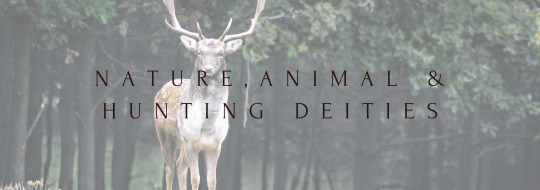
Abnoba
goddess of the hunt, the moon and wildlife
Her name means 'river' or 'water'.
equated with Diana/ Artemis
worshipped in Switzerland, Germany (especially the Black Forest region)
Arduinna
goddess of forests and hunting
depicted as riding a wild boar
possibly equated with Diana/ Artemis
worshipped in France (particularly the Ardennes region), as well as Belgium, Luxembourg and possibly Germany and Italy
Artaius
bear god (his name means 'bear')
equated with Mercury, possible link to King Arthur/ Gwydion
worshipped in France
Artio (Andarta)
bear goddess
depicted as seated, a bowl of fruit in her lap, facing a bear
possibly equated with Diana/ Artemis
worshipped in France, Switzerland, Germany
Cernunnos
god of nature, animals and fruitfulness
His name means 'horn' or antler'
associated with deer, forests, stags, horned serpents, dogs, bulls and rats
often depicted cross-legged, with antlers, wearing or holding a torque, sometimes holding a bag of coins or grains and a cornucopia
He guides the diseased into the afterlife. He is the god of travel, commerce and bi-directionality (mediator between opposites).
associated with Herne the Hunter
worshipped in France, Luxembourg, Britain
Damona
goddess of animals, fertility, healing and abundance
Her name has been interpreted as 'divine crow'.
depicted with a crown of stalks of grain and a snake curling around her hand
worshipped in France (especially Burgundy)
Epona
horse goddess
protector of horses
Her name is translated as 'Great Mare'.
also interpreted as fertility goddess due to her depiction with a patera, cornucopia, ears of grain and foals
depicted sitting on a horse, some say she is the horse
possibly a guide for souls on their journey to the afterlife
worshipped in the eastern Alpes region, Germany, Italy, Iberian peninsula, Britain, Luxembourg, France
Maponos
god of youth and the hunt, possible also fertility and light
depicted as harper standing opposite a Celtic Diana-huntress figure
son of Dea Matrona
equated with Apollo and Mabon
worshipped in France, Britain
Nantosuelta
goddess of nature (earth, fire, water), fertility, home and hearth, abundance, the Otherworld and the dead
Her name is interpreted either as 'she of the winding river' or as 'she of the sun-drenched valley'.
depicted with a bird's house/ a small house (or temple) on a staff, bees and bee hives, apples, a raven, sometimes together with Sucellus
comapared to The Morrígan
worshipped in the Rhine and Moselle regions
Tarvus Tigaranus
bull god
Vosegus
god of hunting and forestation
depicted with a bow and shield, sometimes accompanied by a dog; occasionally associated with nuts, acorns, pine cones
his name is a combination of 'sub'/ 'under' and 'force'/ 'victory'
worshipped around Mont Donon (the highest peak of the northern Vosges in eastern France)
see also: Brigindo, Esus, Sucellus
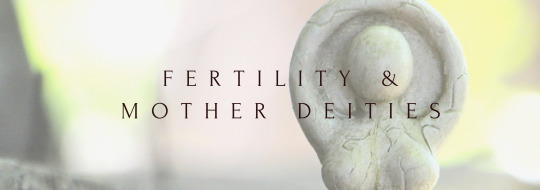
Aveta
mother goddess, goddess of birth and midwifery
depicted with infants, small dogs and a fruit basket
associated with a freshwater spring at Trier (Germany)
worshipped in Germany, France, Switzerland
Dea Matrona (Matres)
mother goddess
triple goddess depicted as three women holding baskets of fruit and flowers, a cornucopia, or nursing infants
protector of children, animals, hearth and home
compared to the Welsh goddess Modron (mother of the god Mabon), equated with Terra Mater
worshipped throughout continental Europe (especially Rhine region)
Rosmerta
goddess of wealth, business and success as well as fertility
Her name means 'the Great Provider'
depicted with a cornucopia, purse, patera, basket of fruit
equated to Mercury
Sucellus
god of good fortune, the woodland and agriculture (fertility), and possibly the underworld
known as 'the good striker' referring to his hammer; When someone is dying, he can put them out of their misery. When he uses his hammer to hit the ground, it creates prosperity.
depicted with his hammer, but also with a large pot filled with food (likely potatoes) and sometimes alcohol, sometimes depicted alongside Nantosuelta
associated with Silvanus and the Irish god Dagda
Xulsigiae
triple goddesses of fertility with connections to solar and mother aspects
possibly connected to water/springs or the home
worshipped in Germany (Trier)
see also: Aericura, Cernunnos, Damona, Epona, Maponos, Nantosuelta, Nehalennia, Sirona
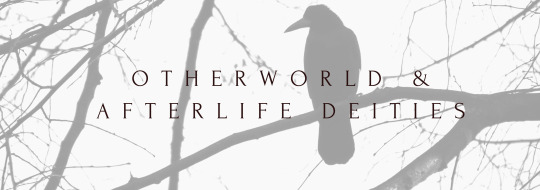
Aericura
goddess of the underworld, fertility, earth
Her name may mean 'she who cares about the copper' or 'protector in battle'
depicted with a basket of apples, a cornucopia, occasionally depicted with Ogmios or accompanied by a wolf or dog
equated to Prosperina and Hecate
worshipped in Germany, Slovenia, Italy, Britain, France
Alisanos
mountain god of earth and underworld
His name means 'rock'/ 'boulder' or 'whitebeam'/ 'alder'
worshipped in France (Burgundy, Aix-en-Provence)
Ogmios
god of communication, eloquence, persuasion, runes
His name is translated as 'sharp', 'stone', 'vault' or 'path'/ 'guide' referring to him leading souls to the afterlife
depicted as wearing a lion skin and wearing a bow or club; He has long chains (of gold or amber) in his smiling mouth that pierce his tongue and are attached on the other end to the ears of a group of men who follow him happily which indicates that he is a binding god.
compared to Heracles and Oghma, the Irish god of eloquence and poetry
worshipped in France, Austria
see also: Nantosuelta, Sucellus
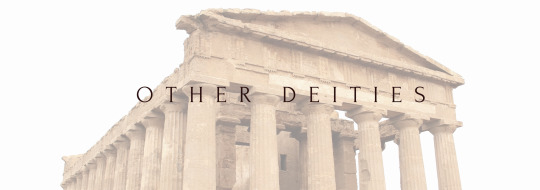
Genius cucullatus (genii cucullati)
protective hooded spirits
Their religious significance is not entirely clear. They may be fertility spirits as sometimes they carry shapes that may be eggs (symbolising life and rebirth). They may also be connected to some kind of warrior cult carrying swords or daggers.
depicted as cloaked figures, usually in triple deity form
worshipped in Germany, Britain
Rudiobus
Not much is known about this god. Only one single inscription was linked to him, found on a bronze figurine of a prancing horse. His name may refer to the colour red.
Notes
A lot of knowledge we have about Gaul deities stems from the Romans and their equation of them with Roman deities. The list below is a (by no means comprehensive) list of Gaulish deities some of which were worshipped only in one particular place or region while others were worshipped from the Iberian peninsula to the north of Britain. (Therefore, some of the deities can be found both in Gaulish and other Celtic culture. Also, many Roman gods - who are not listed her - were later on integrated into the Gaulish pantheon.)
As there was no single Gaulish nation but many different tribes, these deities were not worshipped by all Gauls, and some of them "overlap" - that is, you will find several sun/war/fertility deities.
Some sources suggest that the Celts' (including the Celts of Gaul) religion/ faith was centred around forces or aspects of nature rather than deities resembling humans. It was only with Romanisation that a shift from animism to anthropomorphic polytheism occurred. Thus, this list is not a complete illustration of Gaulish faith but rather a brief overview of some deities without further explanation of their context.
#gaul#gaulish polytheism#celtic#witchblr#pagan#paganism#witchcraft#deity work#cernunnos#ogmios#grimore#grimiore
355 notes
·
View notes
Text
Norse and Celtic Druid Books I recommend

This book talks about the Norse gods and goddesses and gives a good introduction on how to start working with each one.

This book is about the Celtic gods and goddesses and talk about their stories and how to work with each one. Each god gets their own chapter.

This book is about over all general Celtic Druid magic. It talks about hurbs, and rituals, and the fay. As Well as a few gods but not all like the previously mentioned book.
If druidry seems complicated to you and hard to get into I definitely recommend staring with these two celtic books and if the norse gods seem interesting to you but you have a hard time reading the old eddas (I know I do) this book is a great place to start.
#wicca#witchcraft#book of shadows#grimoire#paganism#druidry#celtic#pagan#baby witch#beginner witch#books#book#book recommendations#book rec
458 notes
·
View notes
Text
Who is Cernunnos without Wiccan influence?

Cernunnos has been adopted in the neopagan community as a god of “fertility” and “masculinity”. This is not true to his Gaulish Celtic origins. There’s no surviving mythology of him, so all we know today is from ancient artifacts depicting his iconography and context within the Celtic pantheon. Lets look at what archeologists have gathered from these objects.
His Domains
Crossroads, Paths
Spirit work
Blocking/unblocking paths
Deaths, Ancestors
Change
Wealth
Business
He Guides
Spirit workers
Priests
Diviners
Travelers, Messengers
Funerary Directors
Merchants
Immigrants
Spiritual Associations
Dreams
Sprit work
Ancestral Honor
Graveyard Dirt
Bones, Necromancy, Funerals
Divination
Cernunnos Epithets
“God under the earth”
“Antlered Serpent, Horned Serpent”
“Clearer of Paths”
“Sitter-at-the-crossroads”
“Liminal one”
“God Undying”
“God of the in-between”
“He between life and death”
His Mundane Associations
Roads, Bridges, Fences
Coins, metals, gems
Bread, earth-grown food (like carrots or potatoes)
Bones, mirrors
Sacred Animals
Snakes, Serpents
Deer, Bucks
Cattle, cows
Dogs (hunting breeds)
Where can he be found?
Thresholds
Crossroads
Marketplaces
City limits, borders
Woods
Graveyards
Bridges
What to petition him for?
When you need obstacles unblocked
Hard decisions, significant choices
Spiritual blocks, path direction
Perusing clergy studies
Ancestral work, connecting to the dead
Moving, changing living situation
Invoke transitionary periods
Change
*Disclaimer. This is not to say the Wiccan version of him is wrong or bad. It’s simply inaccurate to his depictions. Wiccans and practitioners are free to worship him whichever way they want, but this post is for those with an interest to his origins.*
Source: https://docs.google.com/document/d/188yMO0_VEum2QL-b04s-fcWRMJkAAEMyFSslIXswdwE/edit
#cernunnos#horned god#masculine#masculine witch#masculine magick#masculine sources#witchcraft#paganism#celtic#celtic paganism#grimore#grimoire
2K notes
·
View notes